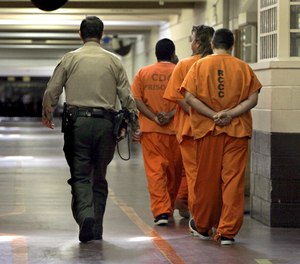By Kaitlyn Schallhorn
The Orange County Register
SACRAMENTO, Calif. — Not too long after the California Legislature finished its 2023 session, a group of legislators went to prison in Norway — not for any nefarious deeds but instead to see if the country’s unique model offered any insight or tools that could be brought back to California.
Sen. Josh Newman and Assemblymember Sharon Quirk-Silva were part of the delegation that traveled to Norway last month — along with a handful of other legislators, formerly incarcerated people and corrections officers — to study its model for incarceration.

Norway’s prison system is a potential remodel for changes to the California incarceration model. (AP Photo/Rich Pedroncelli)
There, after an overhaul of the correctional system in the 1990s, the approach is focused more on rehabilitation, offering inmates training and education.
The idea is to reduce recidivism rates and help those incarcerated become better family members or neighbors once they are released.
“If we know that we are going to be incarcerating people at a much higher rate than we ever have in the last handful of decades,” said Quirk-Silva, “we know that people will get out, and with no rehabilitation, there is a strong likelihood of reoffending, going back in and the pattern repeating.”
“Is there a better way to do this? We certainly saw some examples of that,” she said.
It’s not unusual for legislators to embark on education trips, including overseas, during times when the legislature isn’t in session.
For this six-day excursion, they visited three prisons in Norway: Halden, a maximum security prison; Bastøy, a lower-security facility on Bastøy Island; and Indre Østfold Prison.
Something that stuck out to Quirk-Silva was the effort to instill a sense of normalcy.
Inmates must cook some of their own meals; they go to classes or work where they can earn money for those meals or other expenses. There are parenting classes and opportunities for children or families to spend time together, even overnight, in a supervised “family quarters” area.
“The idea is returning to the community as a better neighbor but also with a trade or a skill,” she said. “They really believe in that humanity — we’ve served our sentence for the crime we’ve committed, and now we’re going to go back to our communities and be productive.”
Newman said the Norway philosophy of “the courts are for punishment and prisons are for making better neighbors” begins almost immediately once someone is incarcerated. That contrasts with systems in California, where inmates have to work their way up to programs that promise job skills or education, he said.
“Our inmates in California are subjected to this culture that can be toxic and dangerous,” Newman said.
And Norway’s model, advocates say, also aids correctional officers as well.
Because of the trauma that California’s correctional officers face, they are more likely to struggle with depression, post-traumatic stress disorder and suicidal thoughts, a 2018 UC Berkeley study found.
In Norway, the relationship between inmates and those ensuring everything runs smoothly is different. As one “prison officer” told the BBC in 2019: “We make sure an inmate serves his sentence, but we also help that person become a better person. We are role models, coaches and mentors.”
Norway’s recidivism rate is reportedly around 25%. In California, with almost seven times the population, the recidivism rate is around 44.6%, according to a California Department of Corrections and Rehabilitation report looking at data from 2017-2018.
“Due to its extremely low recidivism rates and its own recent history of reform, Norway’s prison system has emerged as the worldwide model for corrections best practices,” said Anne Irwin, the founder of Smart Justice California, a criminal justice reform group that hosted the trip along with UC San Francisco’s Amend Program.
Learn more:
So what’s next?
Both Quirk-Silva and Newman said they could see California changing its model in incremental steps.
“It’s totally worth thinking about if there is a better way to do this,” said Newman, adding that he sees opportunities for pilot programs that could model some of Norway’s approach.
Gov. Gavin Newsom last year vetoed a bill meant to enact a similar, albeit scaled-back model, for certain inmates who would be chosen to move to a different facility where they could cook and get job training. The governor axed the bill because of its fiscal impacts, he said.
Quirk-Silva said any legislative effort isn’t meant to be “light on crime.” Instead, she compared it to a school system: “We have to decide as educators, how do we want our students to graduate? What type of person do we want to graduate? What kind of inmate do we want to leave our system?”
©2023 MediaNews Group, Inc.
Visit ocregister.com.
Distributed by Tribune Content Agency, LLC.
This post was originally published on this site be sure to check out more of their content.






